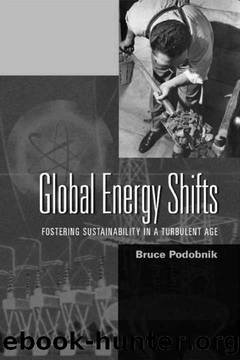Global Energy Shifts: Fostering Sustainability in a Turbulent Age by Bruce Podobnik

Author:Bruce Podobnik
Language: eng
Format: epub
Published: 2010-05-22T16:06:00+00:00
The Postwar Emergence of International Energy Inequalities
The post-Second World War era clearly witnessed important developments in a whole range of energy systems. In both the U.S. and the Soviet spheres of influence, specific social groups gained privileged access to new oil, gas, and electricity resources. Industry was stimulated in these regions, and significant improvements in basic standards of living were achieved. However, this process of development in core and semiperipheral regions masked an intensifying degree of inequality in global patterns of energy consumption. In the American sphere of influence in particular, market forces functioned to exacerbate divisions between those who got access to modern forms of energy and those who were forced to continue relying on traditional biomass resources.
If we look at patterns of energy production and consumption by world region in the period after the Second World War, a new problematic feature of the global energy system is revealed. The nations of the global South have been transferring modern energy resources to wealthier nations at an increasing rate in recent decades. As shown in Figure 5.1, through the end of the Second World War the developed world was almost totally self-sufficient in energy. Since then, however, nations of the global South have been transferring energy resources to nations in the global North at a steady rate.
A number of oil-exporting countries have achieved impressive levels of economic growth on the basis of this trade. However, its main effect has been to intensify long-standing global inequalities in levels of energy consumption. As indicated in Figure 5.2, throughout the modern period core states have attained much higher levels of per capita commercial energy consumption than their semiperipheral or peripheral counterparts. While there was a slight closing of the gap between core and semiperipheral regions during the 1970s, by the mid-1980s long-term patterns of intensifying inequality had reasserted themselves.
If we focus our attention on the post-Second World War period and examine world regions in more detail, we again see enduring patterns of inequality. Figure 5.3 shows that North America (the United States and Canada) has persistently outstripped all other regions in terms of commercial energy consumption. After seeing substantial gains in the three and a half decades following the Second World War, meanwhile, countries in Eastern Europe have undergone a significant decline in consumption. Western Europe, which saw a slight pause following the shocks of the 1970s, has reasserted moderate growth. The Pacific region, which includes Japan, East Asia, and Australia, has seen steady growth. Africa and Asia, meanwhile, have seen little increase in per capita consumption of commercial energy since the 1970s.
Download
This site does not store any files on its server. We only index and link to content provided by other sites. Please contact the content providers to delete copyright contents if any and email us, we'll remove relevant links or contents immediately.
Man-made Catastrophes and Risk Information Concealment by Dmitry Chernov & Didier Sornette(4736)
The Revenge of Geography: What the Map Tells Us About Coming Conflicts and the Battle Against Fate by Kaplan Robert D(3597)
Zero Waste Home by Bea Johnson(3291)
COSMOS by Carl Sagan(2950)
In a Sunburned Country by Bill Bryson(2948)
Good by S. Walden(2915)
The Fate of Rome: Climate, Disease, and the End of an Empire (The Princeton History of the Ancient World) by Kyle Harper(2436)
Camino Island by John Grisham(2383)
A Wilder Time by William E. Glassley(2363)
Organic Mushroom Farming and Mycoremediation by Tradd Cotter(2307)
Human Dynamics Research in Smart and Connected Communities by Shih-Lung Shaw & Daniel Sui(2178)
The Ogre by Doug Scott(2114)
Energy Myths and Realities by Vaclav Smil(2060)
The Traveler's Gift by Andy Andrews(2011)
Inside the Middle East by Avi Melamed(1939)
Birds of New Guinea by Pratt Thane K.; Beehler Bruce M.; Anderton John C(1906)
Ultimate Navigation Manual by Lyle Brotherton(1767)
A History of Warfare by John Keegan(1714)
And the Band Played On by Randy Shilts(1615)
